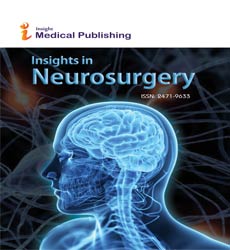Initial Management and Surgical Treatment of Subarachnoid Hemorrhage
Drogo Kelley
Drogo Kelley*
Department of Neurosurgery, University of East London, London, UK
- *Corresponding Author:
- Drogo Kelley
Department of Neurosurgery,
University of East London,
London,
UK,
E-mail: drogo@kelley.co.uk
Received Date: November 09, 2021; Accepted Date: November 23, 2021;Published Date: November 30, 2021
Citation: Kelley D (2021) Initial Management and Surgical Treatment of Subarachnoid Hemorrhage. Neurosurg. Vol.5 No.S1:002.
Description
Subarachnoid Hemorrhage (SAH) may be a complex pathophysiological process following which secondary cerebral Insults are common. A multidisciplinary approach from resuscitation through rehabilitation is required so as to optimize survival and recovery. During the last decade, advances in SAH management, including early surgery, imaging techniques, hypervolemia, calcium channel blockers, endovascular treatment and aggressive medical care have provided a chance to enhance overall outcome. Despite these improvements, the mortality and morbidity related to SAH remain high. Continued efforts got to be made so as to know more about the etiological and pathogenetic processes at work in SAH. Endovascular treatment and screening plays a prominent role which needs a particular attention.
Intracranial vessels lie within the space, giving off small perforating vessels. Hemorrhage from these vessels or from an associated aneurysm occurs primarily into this space, leading to SAH. Cerebral aneurysms are the most frequent cause of spontaneous SAH, with Arteriovenous malformations although other causes include trauma and tumors.
Initial management
The main aim in the early management of SAH is stabilization of the patient, with optimization for aneurysm obliteration, together with the prevention of secondary cerebral insults. Initial priorities include adequate ventilation and oxygenation, normovolemia and hemodynamic stability and control of intracranial pressure (ICP). In all patients, bed rest is suggested until aneurysm obliteration is often undertaken. Frequent neurological examination is required so as to spot any neurological deterioration requiring further investigation or management. The prophylactic use of nimodipine, at a dose of 60 mg 9-hourly, is used in most centers, as it has been shown to improve outcome. With an unsecured aneurysm, gentle volume expansion with slight hemodilution may help to return the circulating volume to normal and stop or minimize the consequences of vasospasm. However, hypertension should be avoided. Central venous pressure measurement in all SAH patients is recommended to allow accurate assessment of the hydration of the patient, although this is not routine practice in all units. Aggressive peri-and post-operative medical care could also be related to improved outcome, with a decrease within the incidence of medical complications and secondary cerebral insults. A number of systemic and intracranial alterations occur in this complex pathophysiological event of SAH. These changes are more prevalent in poor grade patients and are often associated with subsequent Dissociative Identity Disorder
Surgical treatment
by clipping has, until now, been the foremost effective treatment known. Timing of surgery, however, remains a crucial and controversial consideration within the management of the patient with a ruptured aneurysm. With improvements in microsurgical techniques and intensive care of patients, the Cooperative Study on the Timing of Aneurysm Surgery was set up in an effort to establish outcome related to timing of surgery. This was a prospective, observational, epidemiological survey using the patient's neurological and disability status at 6 months, rates of vasospasm and rebleed and medical and surgical complications as outcome measures. The mortality associated with intervening events in patients treated with delayed surgery was nearly equal to the post-operative mortality after early surgery; however, rates of good recovery were significantly improved with early surgery, a good outcome being seen in those operated on at 0-3 days than surgery performed at greater than 10 days. There attended be similar technical difficulties in early and delayed surgery, although a swollen, tight brain was more frequent in patents operated on acutely. Other studies have shown a similar tendency, with early surgery resulting in a more favorable outcome with an equally common risk of adverse intraoperative events in those patients operated on early or late. Neurological grade and age of the patient are the foremost important patient related factors. The Cooperative Study showed that if patients were alert at admission, outcome was favorable than who were admitted in coma made a good recovery. Age of the patient tends to be inversely associated with favorable outcome, particularly in those who are aged above 60 years. Elderly patients treated conservatively have mortality and aggressive management, including surgery, remains their best chance of returning to an independent existence.
Open Access Journals
- Aquaculture & Veterinary Science
- Chemistry & Chemical Sciences
- Clinical Sciences
- Engineering
- General Science
- Genetics & Molecular Biology
- Health Care & Nursing
- Immunology & Microbiology
- Materials Science
- Mathematics & Physics
- Medical Sciences
- Neurology & Psychiatry
- Oncology & Cancer Science
- Pharmaceutical Sciences
